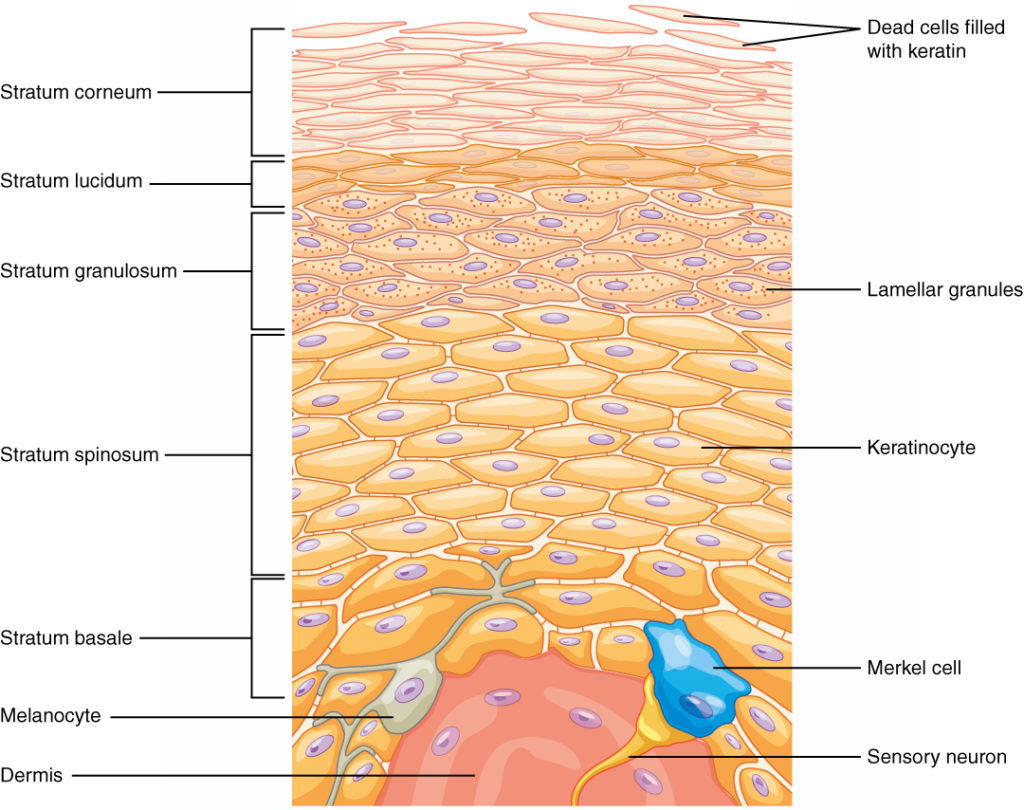How important are ceramides?
Two answers, depending on where the ceramides are.
1) In the skin, ceramides are very important.
2) On the skin, ceramides are not that important.
Please, explain!
1) The ceramides your skin makes are very important; they fulfill an important role (see below)
2) When applied in skin care products, ceramides are not important and are replaceable.
What do ceramides do inside the skin?
How good is the skin at protecting our bodies? It’s excellent when it’s healthy. The horny layer is a compact wall of corneocytes and unique fat molecules. In the analogy with a wall, the corneocytes are the bricks, and the intercellular lipids, including ceramides and proteins, are the mortar. The horny layer (stratum granulosum) lacks live cells but is the protective barrier that allows the rest of the skin to do its job. Preventing trans-epidermal (through-the-skin) water loss (TEWL) is one of the main functions of the horny layer. in conjunction with cholesterol and saturated fatty acids, ceramides create a protective coating that prevents excessive water loss due to evaporation and is a barrier against microorganisms’ entry.

Figure: structure of the skin.
How and when did the skin make those important ceramides?
The basal keratinocytes divide and form the keratinocytes of the granular layer. The keratinization process starts with synthesizing fibrillar proteins, and the shape and composition of the keratinocytes changes. In the next layer, the granular cells make histidine- and cysteine-rich proteins that bind the keratin filaments together; they secrete lipids and proteins to the intercellular space allowing the skin to become a barrier to water loss. The cells lose the nuclei and become the dead cells that make up the horny layer (stratum corneum), embedded in a lipid mixture consisting mainly of a lamellar structure of ceramides, cholesterol, and free fatty acids.
Ceramides and the skincare industry: there is a more clever approach
Some ingredients used in the skincare industry, like ceramides and sodium PCA, are chosen from those present naturally in the skin. We must understand that the body solves problems by transforming the available raw materials. When we look at the “solutions” the body has designed, like the natural moisturizing factor (NMF), or ceramides in the epidermis, or vernix caseosa (the waxy coat that covers the newborns), we should try to understand how they work.
The functionality of body chemicals is not tied to the identity of the chemicals, and our aim is to replicate the functionality or improve on it, not just copy the chemicals.
Ceramides are made by the epidermis using the fatty acids contained in the live cells. Should we copy the complicated structure of natural ceramides? is that what the skincare industry does? Actually, it’s not possible (or desirable). The skin makes ceramides with whatever it’s available, and those raw materials vary. The purpose is simply to make that waterproof cement. Ceramides are chemically composed of a sphingoid base, long-chain amino alcohol (long-chain base), and a fatty acid joined by an amide bond. The sphingoid base may consist of dihydrosphingosine, sphingosine, phytosphingosine, or 6-hydroxy sphingosine. The fatty acid may be a non-hydroxyl, an α-hydroxyl fatty acid, or an esterified ω-hydroxyl FA. Various ceramides are created by different combinations of these two types of molecules.
The complexity of the ceramide composition within the skin can’t be achieved, and there is no reason to attempt that anyway. Whatever ceramides you apply to the skin, synthetic, plant-derived or animal-derived, they will not go where your own ceramides should be. Once we understand how ceramides do their job, we can start looking at more effective ways of emulating them. For example, ceramides are expensive to source from acceptable materials (the brain is not an acceptable source!) that will do a similar or better job without the expense, monetary and ecological.
What to do
It makes sense to start taking care of your skin by avoiding routines that remove these natural components, including endogenous ceramides. Preserving the original chemicals that make the skin a barrier will go a long way in preventing “sensitive skin,” a problem created by the skincare industry and by users that believe in extreme cleansing.
It’s important to understand that applying ceramides present in skincare products will not help you much. What will?
1) Supply ingredients the skin can use to make its ceramides
2) Avoid losing your own all-important skin lipids
3) Use ELS from Skin Actives! Your skin will know how to use this fantastic combination of lipids to make its own ceramides
4) If your skin barrier is disrupted, apply a good cream that contains ingredients that your skin will use to heal and regenerate. You can always add a hint of petrolatum (bought in the supermarket for a couple of dollars per pound) to substitute for the damaged skin barrier.
References
Cha, H. J., HE, C., Zhao, H., Dong, Y., An, I.-S., & An, S. (2016). Intercellular and intracellular functions of ceramides and their metabolites in skin (Review). International Journal of Molecular Medicine, 38(1), 16–22. doi:10.3892/ijmm.2016.2600
More about ceramides: here, here and here.
DISCLAIMER: These claims have not been evaluated by the FDA and are not intended to diagnose, cure, treat or prevent any disease.
